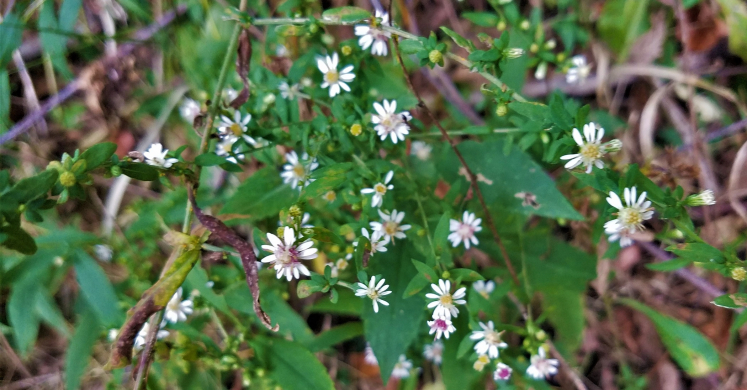Blog

#bioPGH: Blooming in My Backyard
 A resource of Biophilia: Pittsburgh, #bioPGH is a weekly blog and social media series that aims to encourage both children and adults to reconnect with nature and enjoy what each of our distinctive seasons has to offer.
A resource of Biophilia: Pittsburgh, #bioPGH is a weekly blog and social media series that aims to encourage both children and adults to reconnect with nature and enjoy what each of our distinctive seasons has to offer.
I discovered white snakeroot growing in my backyard a few weeks ago, and this week, I noticed something new blooming that I didn’t recognize. With the help of my trusty iNaturalist app, it appears to be calico aster — which makes sense given it blooms until October. The problem was this plant has a few look-alikes, and I wanted to be certain. Well, we’ve gone on plant-identity adventures before here on the blog, so let’s do another deep dive on this one!
It seems that my backyard bloom is calico aster, but the exact identity is a bit tricky to pin down. As the Ladybird Johnson Wildflower Center points out, calico asters are “one of a group of closely related white, narrow-leaved asters that presumably interbreed and are difficult to distinguish.” Other possibilities for my little horticultural whodunit are white heath asters, hairy white oldfield aster, and Drummond’s aster. All of these plants are comparable in size and appearance, and as noted above, they can also hybridize — which adds a possible twist to the mystery. I looked up the other possibilities, and I’m a bit less confident about them. White heath asters, for example have blunt bracts beneath the flowerheads, but my backyard asters have pointed bracts. Also, the leaves, stems and branches aren’t hairy as one would expect from the aptly named “hairy” white oldfield aster; and the flowers (well, inflorescences) themselves are only about a third to at most a half an inch across, rather than the three-quarters of an inch, as one might expect from Drummond’s aster. Granted, we do also know that there is some variability in appearance for calico aster, but still, calico aster is my most likely bet!
Whew! Well, now that it seems we have the identity of my backyard bloom determined, we can learn a bit more about the biology of the plant. Calico asters are another member of Asteraceae, and they are indeed native to North America. The plants generally grow 1-3 feet tall, and the long branches are dotted with little flowerheads. The species has quite a wide distribution range, from Ontario to Florida and from the east coast to just west of the Mississippi, suggesting they can adapt to a range of habitat types. They tend to bloom in late summer, from as early as August to as late as October, and mine certainly are attracting pollinators like bees as many garden flowers have died back for the season. Calico asters are also perennial, so I will have to be sure to watch out for them this time next year!
I’m quite excited that even though there are certainly some invasive plants in my yard (I’m looking at you, garlic mustard), I also have an assortment of native plants! I’m so happy to support native biodiversity quite literally in my own backyard.
Connecting to the Outdoors Tip: If you're looking for this flower around a park or even your own backyard, keep an eye on areas where there is at least partial sun. This plant may be found along the edfes of fields and trails, and you can always take a look on iNaturalist for where it has already been spotted!
Continue the Conversation: Share your nature discoveries with our community by posting to Twitter and Instagram with hashtag #bioPGH, and R.S.V.P. to attend our next Biophilia: Pittsburgh meeting.
Photos: Maria Wheeler-Dubas

